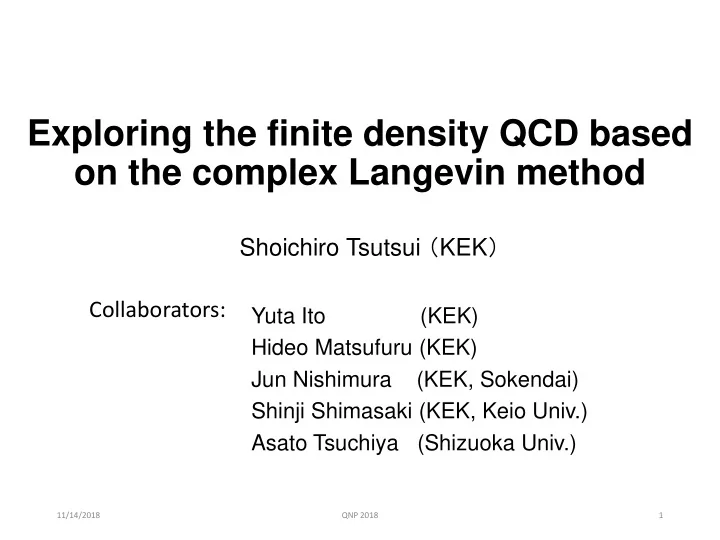

Exploring the finite density QCD based on the complex Langevin method Shoichiro Tsutsui ( KEK ) Collaborators: Yuta Ito (KEK) Hideo Matsufuru (KEK) Jun Nishimura (KEK, Sokendai) Shinji Shimasaki (KEK, Keio Univ.) Asato Tsuchiya (Shizuoka Univ.) 11/14/2018 QNP 2018 1
Conjectured QCD phase diagram Quark-gluon plasma 1 st order deconfinement phase transition Color superconductor Hadron phase etc. 11/14/2018 QNP 2018 2
Conjectured QCD phase diagram Quark-gluon plasma 1 st order deconfinement phase transition Sign problem Color superconductor Hadron phase 11/14/2018 QNP 2018 3
Finite density QCD QCD partition function The origin of the sign problem is complex when A promising way to solve the sign problem: Complex Langevin method (CLM) 4 11/14/2018 QNP 2018
Complex Langevin method for QCD [Parisi ‘83], [ Klauder ‘84] [Aarts, Seiler, Stamatescu ‘09] [Aarts, James, Seiler, Stamatescu ‘11] [Seiler, Sexty, Stamatescu ‘13] [Sexty ‘14] [Fodor, Katz, Sexty, Torok ‘15] [Sinclair, Kogut ‘16] [Nishimura, Shimasaki ‘15] [Nagata, Nishimura, Shimasaki ‘15] Complexification The complex Langevin eq. of QCD Drift term 5 11/14/2018 QNP 2018
Setup Nf = 4, staggered fermion Lattice size: 8 3 × 16 β = 5.7 μ a = 0.0 – 0.5 Quark mass: m q a = 0.01 Number of Langevin steps = 10 4 – 10 5 Computer resources: K computer Lattice spacing: a ~ 0.045 fm 11/14/2018 QNP 2018 6
Criterion of correctness The CLM sometimes gives incorrect results. Exponential falloff of the drift distribution Complex Langevin is reliable Power-law falloff of the drift distribution Complex Langevin gives incorrect answer [Nagata, Nishimura, Shimasaki ‘15 ] The main causes of the power-law falloff: Excursion problem : large deviation of the link variables from SU(3) Singular drift problem : nearly zero eigenvalues of the fermion matrix generate an unreasonably large drift term 11/14/2018 QNP 2018 7
Criterion of correctness Excursion problem: We have checked 1. Gauge field contributions to the drift term 2. Time dependence of the unitarity norm (distance on SL(3,C)) Singular drift problem: We have checked 1. Fermion contributions to the drift term 2. A snap shot of the eigenvalue distribution of (D+m) This is the first time to show for the full QCD configurations generated by complex Langevin method. 11/14/2018 QNP 2018 8
Histogram of the drift term reliable data are obtained at μ= 0.1, 0.4 (*) Fermionic contribution is shown. 11/14/2018 QNP 2018 9
Eigenvalue distribution of (D+m) imaginary part μ =0.1 μ=0. 2 real part μ=0.4 μ=0.3 11/14/2018 QNP 2018 10
Eigenvalue distribution for reliable data imaginary part μ =0.1 We find gapped distribution at μ=0.1, 0.4, where the singular drift problem does not occurs. real part μ=0.4 11/14/2018 QNP 2018 11
Eigenvalue distribution for unreliable data μ=0. 2 Distributions at μ=0.2, 0.3 are also gapped. Why? μ=0.3 • These are just snap shots. • Eigenvalue distribution may have large fluctuations in the vicinity of the phase transition line. 11/14/2018 QNP 2018 12
Polyakov loop Phase quenched Complex Langevin μ confined phase (due to the finite spatial volume effect) deconfined phase * Physical temperature is above Tc. 11/14/2018 QNP 2018 13
Quark number Baryon number density × Volume × 3 confined phase Quark number = deconfined phase μ What is the origin of the plateaus? 11/14/2018 QNP 2018 14
Quark number 24/3 = 8: 8-baryon state 8/2 = 4: 4-meson state μ Phase quenched (PQ): μ plays a role of “isospin chemical potential”. → Meson state is produced. Complex Langevin: Quark number at the plateau can be divided by 3. → Baryon state is produced. 11/14/2018 QNP 2018 15
Summary and outlook Complex Langevin method is applied to 4-flavor QCD in finite density region. We have confirmed that the eigenvalue distribution of (D+m) has a gap at the origin when the singular drift problem does not occur. The origin of the plateau of the quark number can be regarded as a baryon state in a (small) box. We have performed further simulations on 16 4 lattice. We have found that the system is in the deconfined phase in the setup. We have also checked that there in no singular drift problem. There is a window ( 0.1<μ<0.5 ) where the complex Langevin works 11/14/2018 QNP 2018 16
Appendix 11/14/2018 QNP 2018 17
Histogram of the drift term (bosonic part) 11/14/2018 QNP 2018 18
Chiral condensate μ 11/14/2018 QNP 2018 19
Baryon number density μ 11/14/2018 QNP 2018 20
Polyakov loop μ 11/14/2018 QNP 2018 21
680MeV Pion mass 300MeV 840MeV 530MeV 600MeV 750MeV 11/14/2018 QNP 2018 22
Basic idea of complex Langevin method [Parisi 83], [Klauder 84] [Aarts, Seiler, Stamatescu 09] [Aarts, James, Seiler, Stamatescu 11] [Seiler, Sexty, Stamatescu 13] [Sexty 14] [Fodor, Katz, Sexty, Torok 15] [Nishimura, Shimasaki 15] Complexification [Nagata, Nishimura, Shimasaki 15] Complex Langevin equation :noise average We identify the noise effect as a quantum fluctuation. 23 11/14/2018 QNP 2018
Justification of complex Langevin method Associated Fokker-Planck-like equation becomes, Under certain conditions , The stationary solution reads 24 11/14/2018 QNP 2018
Criterion of correctness A criterion for the correctness of the complex Langevin method K. Nagata, J. Nishimura, S. Shimasaki [1508.02377, 1606.07627] Drift term Probability distribution of the magnitude of the drift term plays a key role. 11/14/2018 QNP 2018 25
Phase diagram of QCD with 4-flavor staggered fermion 1 st order chiral phase transition at μ =0 phase transition at finite μ (not completely established) Finite-size scaling analysis [Fukugita, Mino, Okawa, Ukawa ‘90] Canonical method [de Forcrand, Kratochvila ‘06] [Li, Alexandru, Liu, Meng ‘10] Reweighting and complex Langevin [Fodor, Katz, Sexty, Torok ‘15 ] [Engels, Joswig, Karsch, Laermann, Lutgemeier, Petersson ‘96] 11/14/2018 QNP 2018 26 26
Recommend
More recommend